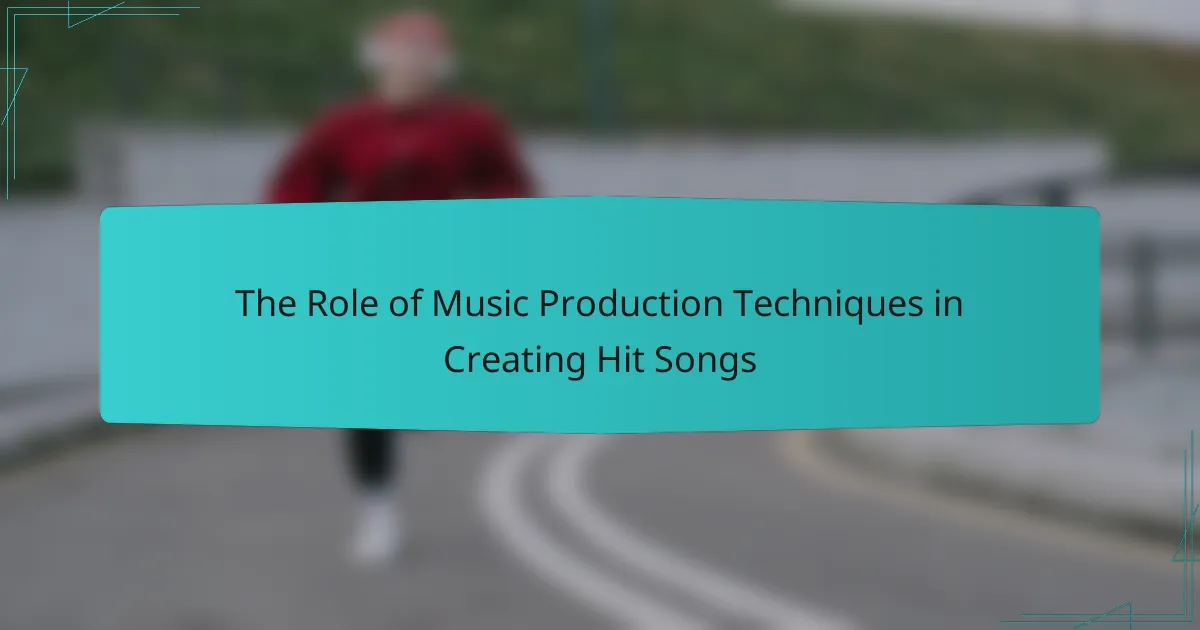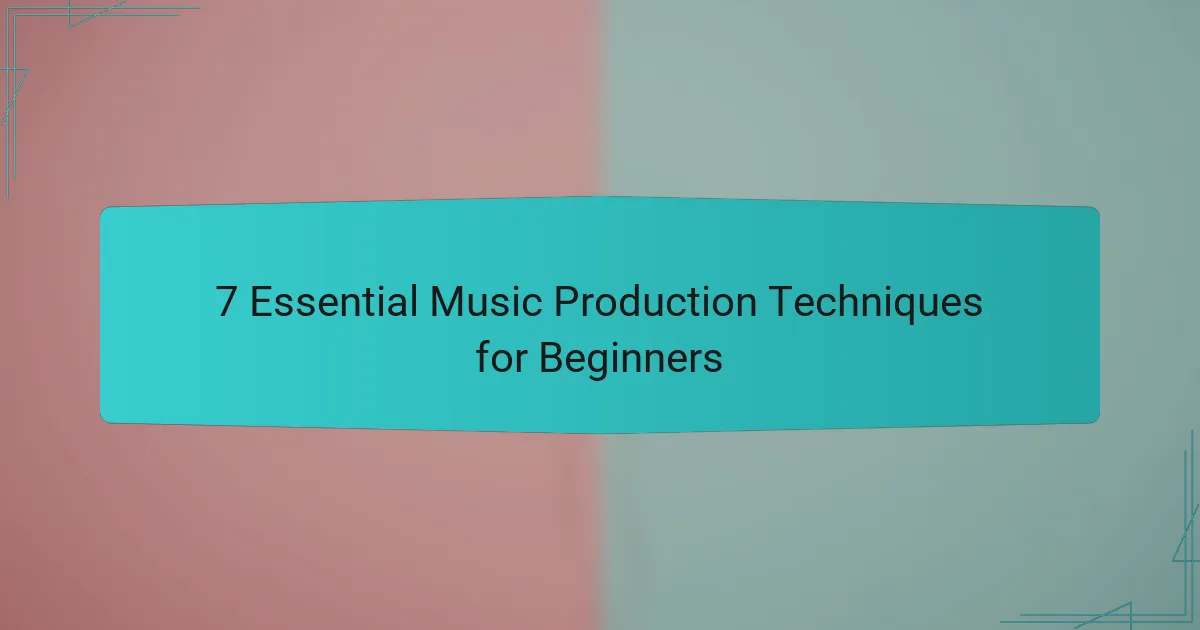Music production techniques play a crucial role in crafting hit songs by enhancing their overall appeal and emotional resonance. By employing strategies such as layering instruments, utilizing automation, and refining vocal production, producers can significantly elevate a track’s quality and listener engagement. Aspiring producers can hone their skills by exploring digital audio workstations and analyzing successful tracks, ultimately developing their unique sound in the competitive music landscape.

How do music production techniques influence hit song creation?
Music production techniques significantly shape the creation of hit songs by enhancing their appeal and engagement. Effective use of arrangement, sound design, and mixing can elevate a track’s potential to resonate with listeners and achieve commercial success.
Impact of arrangement on listener engagement
The arrangement of a song plays a crucial role in maintaining listener interest. By strategically placing verses, choruses, and bridges, producers can create dynamic shifts that keep the audience engaged throughout the track.
For instance, introducing a catchy hook early in the song can capture attention, while varying the instrumentation in different sections can sustain interest. A well-structured arrangement often leads to higher replay value, which is essential for a hit song.
Role of sound design in genre appeal
Sound design is vital in defining a song’s genre and its overall appeal to specific audiences. Unique sounds and textures can set a track apart, making it more memorable and relatable to fans of particular styles.
Producers should consider using genre-specific instruments and effects, such as synthesizers in electronic music or acoustic elements in folk. Experimenting with sound layers can also enhance the richness of a song, attracting a broader listener base.
Importance of mixing for commercial success
Mixing is essential for ensuring that all elements of a song are balanced and polished, which is critical for commercial success. A well-mixed track allows vocals to shine while ensuring that instruments complement rather than overpower each other.
Producers should focus on achieving clarity and depth in the mix, utilizing techniques like equalization and compression effectively. Poor mixing can lead to a lackluster listening experience, potentially diminishing a song’s chances of becoming a hit.

What are the key music production techniques for hit songs?
Key music production techniques for creating hit songs include layering instruments, using automation for dynamics, and effective vocal production. These methods enhance the overall sound quality and emotional impact, making the track more appealing to listeners.
Layering instruments for depth
Layering instruments involves combining multiple sounds to create a fuller and richer audio experience. This technique can be applied to drums, synths, and guitars, allowing producers to blend different textures and frequencies. For instance, using two different guitar tracks—one clean and one distorted—can add depth and interest to a song.
When layering, it’s essential to consider frequency ranges to avoid muddiness. Aim to have each layer occupy its own space in the mix, which can be achieved through panning and EQ adjustments. A common practice is to use complementary sounds that enhance each other rather than compete for attention.
Use of automation in dynamics
Automation in music production refers to the process of adjusting volume, panning, or effects over time to create dynamic changes in a track. This technique can help maintain listener interest by adding movement and variation throughout the song. For example, gradually increasing the volume of a vocal track during a chorus can make it stand out more effectively.
Producers should use automation judiciously to avoid overwhelming the listener. Subtle changes often yield the best results, so consider automating parameters in small increments. Additionally, utilizing automation to highlight specific sections, like a bridge or a breakdown, can enhance the emotional impact of the song.
Vocal production and effects
Vocal production is crucial in making a hit song, as the vocals are often the focal point. This includes recording techniques, pitch correction, and the application of effects such as reverb and delay. A well-produced vocal track should sound clear and engaging, drawing the listener’s attention.
When working with vocals, consider using compression to maintain a consistent volume level and adding effects to create a sense of space. For instance, a touch of reverb can make the vocals feel more immersive. However, avoid over-processing, as this can lead to a loss of authenticity and emotional connection.

How can aspiring producers implement these techniques?
Aspiring producers can effectively implement music production techniques by familiarizing themselves with digital audio workstations (DAWs), studying successful artists, and practicing regularly. Engaging with these elements will help them develop their unique sound and improve their production skills.
Utilizing DAWs like Ableton Live
Using DAWs such as Ableton Live allows producers to manipulate sound with precision and creativity. This software offers a range of tools for recording, editing, and arranging music, making it accessible for both beginners and experienced producers.
Producers should explore features like MIDI sequencing, audio effects, and sample libraries within Ableton Live. A practical approach is to start with simple projects, gradually incorporating more complex elements as confidence grows. Regularly experimenting with different sounds can lead to discovering unique styles.
Learning from industry examples like Billie Eilish
Studying the production techniques of successful artists like Billie Eilish can provide valuable insights into creating hit songs. Eilish’s use of minimalistic production, layered vocals, and innovative sound design showcases how less can be more in music.
Aspiring producers should analyze specific tracks to understand how elements like dynamics, arrangement, and vocal processing contribute to the overall impact. Emulating these techniques in their own work can help producers refine their style while developing a keen ear for what resonates with listeners.

What criteria should be considered when selecting production tools?
When selecting production tools for music creation, consider factors such as budget, compatibility with existing hardware, and the specific features that enhance your workflow. These criteria will help ensure that the tools you choose effectively support your music production goals.
Budget considerations for software
Budget plays a crucial role in selecting music production software. Prices can range from free options to several hundred dollars for professional-grade software. Assess your needs and determine how much you are willing to invest, keeping in mind that many reputable software options offer trial versions.
When budgeting, consider not only the initial purchase price but also potential ongoing costs, such as subscription fees for updates or additional plugins. Look for bundled deals that may offer savings on multiple tools.
Compatibility with hardware
Ensure that your chosen production tools are compatible with your existing hardware, including your computer’s operating system and audio interface. Check the software’s system requirements to avoid performance issues or crashes.
Additionally, consider how well the software integrates with your other equipment, such as MIDI controllers and synthesizers. Compatibility can significantly enhance your workflow, allowing for smoother transitions between different production stages.
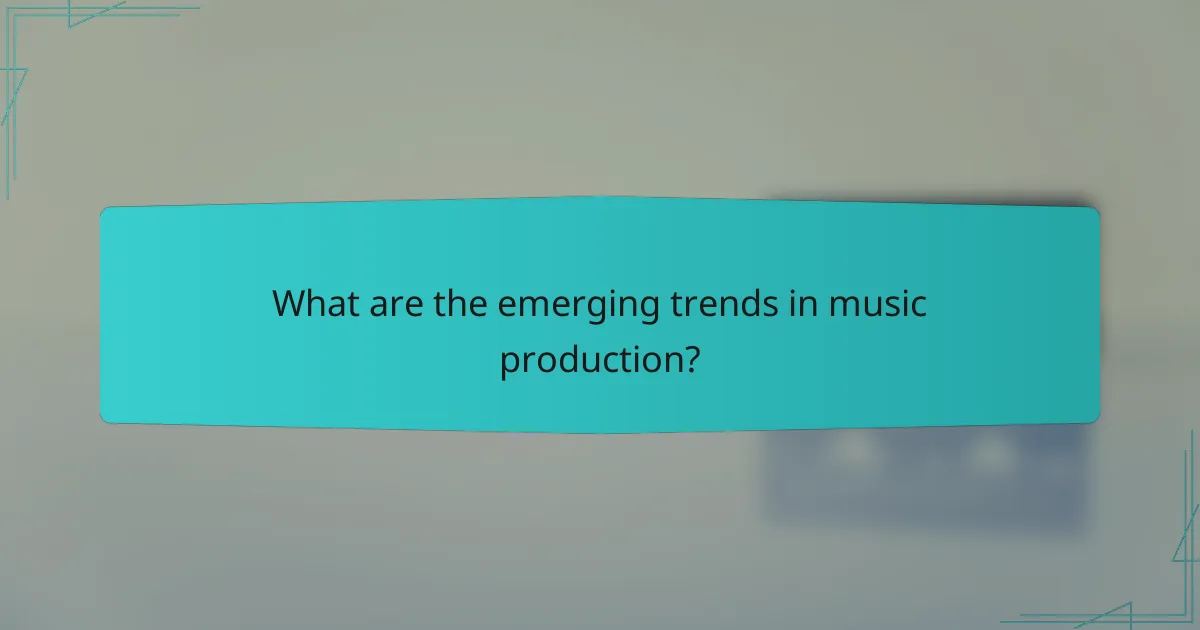
What are the emerging trends in music production?
Emerging trends in music production focus on integrating advanced technology and innovative techniques to enhance creativity and streamline workflows. Key developments include the use of AI tools for composition and the incorporation of virtual reality to create immersive music experiences.
AI tools for music composition
AI tools are revolutionizing music composition by assisting artists in generating melodies, harmonies, and even lyrics. These tools analyze vast amounts of existing music to create new compositions that align with popular trends and styles.
Producers can use AI-driven software to quickly generate ideas, saving time during the creative process. Popular platforms like Amper Music and AIVA allow users to customize compositions based on genre, mood, and instrumentation, making it easier to produce hit songs.
However, relying too heavily on AI can lead to a lack of originality. It’s essential for musicians to balance AI-generated content with their unique artistic vision to maintain authenticity.
Virtual reality in music experiences
Virtual reality (VR) is transforming how audiences experience music by creating immersive environments that enhance live performances and music videos. VR technology allows fans to feel as though they are part of the performance, offering a unique way to engage with artists and their work.
For instance, platforms like Oculus Venues enable users to attend virtual concerts, interact with other fans, and even explore 3D environments designed around the music. This trend is particularly appealing to younger audiences who seek novel experiences.
While VR can significantly enhance the music experience, it requires investment in technology and production skills. Artists and producers should consider the costs and technical requirements when integrating VR into their projects to ensure a seamless experience for their audience.
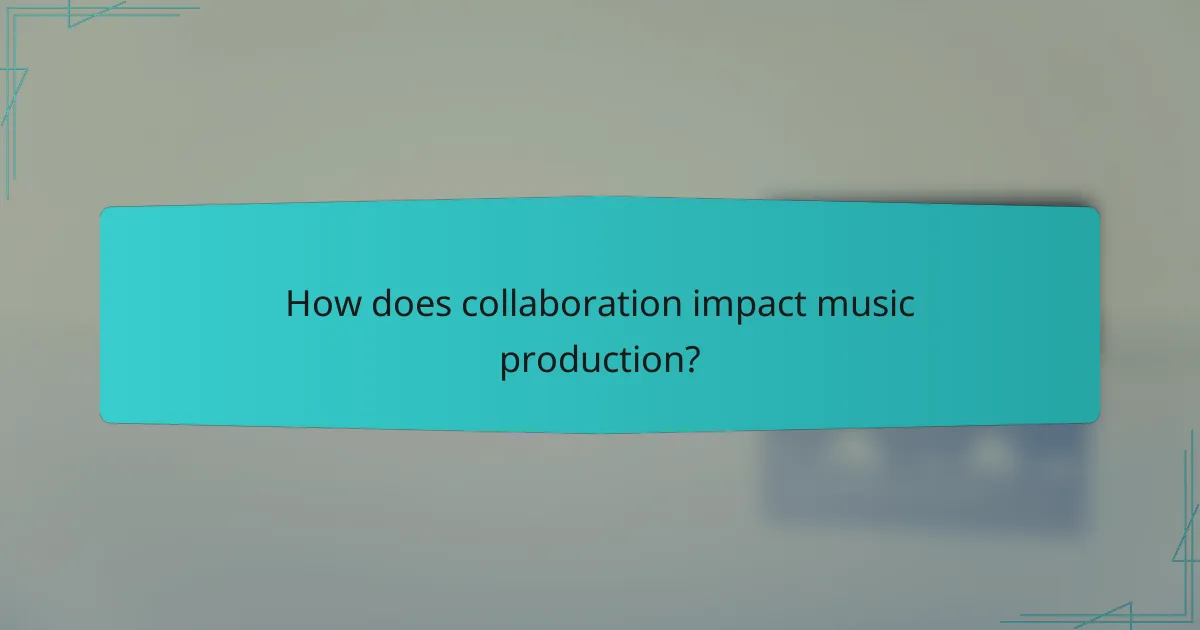
How does collaboration impact music production?
Collaboration significantly enhances music production by bringing together diverse skills, ideas, and perspectives. Working with others can lead to innovative sounds and more polished final products, as each collaborator contributes their unique strengths to the project.
Benefits of co-producing with established artists
Co-producing with established artists can elevate a song’s quality and marketability. These artists often have refined techniques and insights that can help shape the production process, ensuring the final product resonates with audiences.
Additionally, established artists typically have access to better resources, including high-quality studios and experienced session musicians. This can result in a more professional sound and a quicker production timeline.
Networking in major music cities
Networking in major music cities like Los Angeles, Nashville, or London can open doors to valuable collaborations. These cities are hubs for talent, offering opportunities to connect with industry professionals, including producers, songwriters, and artists.
Engaging in local music events, workshops, and showcases can help build relationships that lead to collaborative projects. It’s essential to be proactive and maintain connections, as the music industry often thrives on word-of-mouth and personal recommendations.
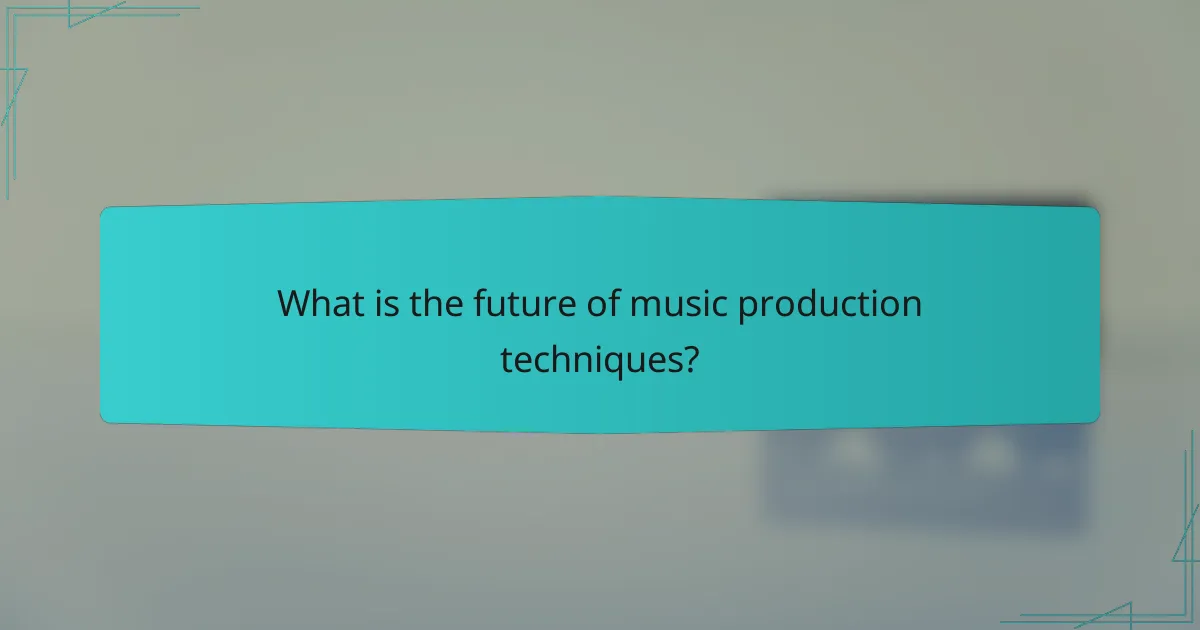
What is the future of music production techniques?
The future of music production techniques is likely to be shaped by advancements in technology, particularly through the integration of artificial intelligence and improved collaborative tools. These developments will enhance creativity and efficiency, allowing artists to produce high-quality music more easily.
Integration of machine learning in sound design
Machine learning is revolutionizing sound design by enabling producers to analyze vast amounts of audio data and generate unique sounds. This technology can identify patterns and preferences, allowing for the creation of personalized audio experiences tailored to specific audiences.
For example, algorithms can suggest chord progressions or melodies based on existing tracks, streamlining the creative process. Producers should consider using machine learning tools to enhance their workflow, but they must also remain mindful of maintaining their artistic vision amid automation.
Evolution of remote collaboration tools
Remote collaboration tools have evolved significantly, making it easier for artists and producers to work together from different locations. Platforms like Splice and Soundtrap allow for real-time sharing and editing of music projects, fostering creativity without geographical constraints.
When using these tools, it’s essential to establish clear communication and set deadlines to ensure smooth collaboration. Additionally, understanding the features of each platform can help maximize productivity and minimize potential pitfalls, such as version control issues.
